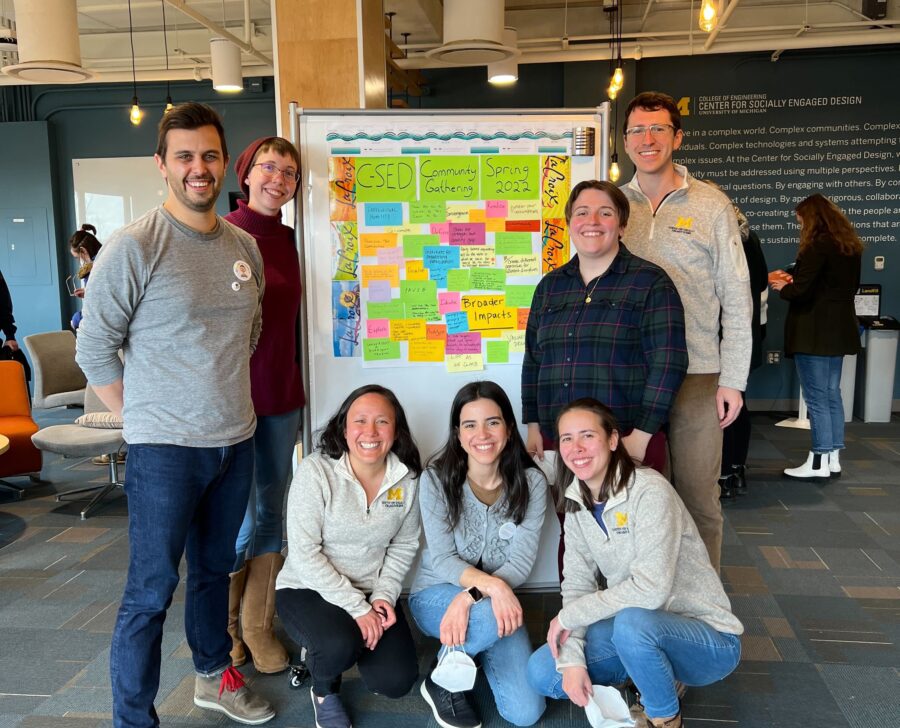Shannon Clancy: A C-SED Superstar
Story by Malin Andersson
Shannon Clancy’s exploration into the world of engineering and socially engaged design has been one characterized by self-discovery, community, mentorship, and a passion for teaching.
In her time at C-SED, Shannon has been nothing short of a superstar. From leading or co-leading over 60 workshops as a grad facilitator, managing the lab, mentoring new facilitators, and helping revise, update, and develop core workshop content, Shannon has displayed their passion for engineering, engagement, and, most importantly, inclusive student support.
As they prepare to enter the next stage of their ever-expanding career, the Center for Socially Engaged Design sends our gratitude and admiration with them.

Shannon’s most recent headshot
Navigating Interests and Uncertainty
When Shannon was a kindergartner in Pasadena, Maryland, she was asked what she wanted to be when she grew up. Confidently, she replied that they wanted to stay in school forever if she could – a wish that Shannon would go on to fulfill unintentionally.
But, when it came time for Shannon to pick what to study, they felt overwhelmed by the options.
“I felt lost in choosing a major,” describes Shannon. “Everything from engineering to anthropology to publishing was interesting. I’ve always loved learning.”
That’s when Shannon’s father, who recognized her aptitude for math and science, suggested that she consider going into engineering. Intrigued, Shannon looked into the possibility and found themselves resonating with the opportunity to problem-solve and make a real impact. So, they decided to give it a try.
Finding community
In August 2015, Shannon began her studies at the University of Maryland, Baltimore County (UMBC). There, Shannon found a supportive community thanks to the Center for Women in Technology (CWIT) scholarship program for women and other minorities in IT and engineering. This program provided her with supportive resources and a sense of belonging.
“I got a lot from that experience,” says Shannon. “I liked having a community with other women and queer people who were interested in engineering and enjoyed math and design. People who supported and mentored each other.”
Shannon decided to further explore their passion for working with students by becoming an RA and, later, a teaching fellow. Eager to learn more and inspired by the teaching style of their mentor, Professor Jamie “Prof G” Gurganus, Shannon began co-teaching her own discussion section of about 25 engineering students during her junior year.
“Between both of my positions as a Teaching Fellow and Resident Assistant, I really loved working with students. I loved mentoring, learning with students, and teaching with care,” describes Shannon. “Ultimately, these experiences got me interested in holistically supporting, developing relationships with, and teaching engineering college students.”

Shannon with Professor Jamie “Prof G” Gurganus
Deciding to pursue a Ph.D.
Determined to pursue a career in teaching, they sought guidance from their mentors on “how to teach undergraduates forever.” That’s when they realized that a Ph.D. may be the answer.
Although they had no background experience in research at the time of their applications, Shannon sought out programs in engineering education. At one particular grad fair, they walked by a U-M booth. There, she serendipitously learned about and decided to pursue the EGS (now EMERGE) program which gives applicants the opportunity to visit the campus and learn about the College of Engineering’s PhD programs.
At the end of her time with EGS, Shannon was impressed and incredibly interested in the university. She was drawn to the region as well as the additional support offered to her. She ended up applying and was accepted to the Mechanical Engineering Ph.D. program, as she didn’t have an engineering master’s degree that was required by the U-M Engineering Education Research program at the time.
A few months later, while sitting in the Detroit airport after the end of their Mechanical Engineering Admitted Student Day Visit, Shannon accepted their offer at Michigan.
An Introduction to Socially Engaged Design
Shannon’s early days at Michigan Engineering were challenging. When the COVID-19 pandemic shifted everything online during her first year as a grad student, Shannon suddenly had the time to think more deeply about her career goals. Though they initially researched cold start emissions in internal combustion engines, Shannon realized that their heart was set on design and engineering education.
“I enjoyed learning about engines, and working for my amazing advisor and with many of my colleagues, but I knew I wanted to focus on design and engineering education research as opposed to combustion research.” (Shannon Clancy)
As she sought out the best plan of action, Shannon remembered feeling inspired by Dr. Shanna Daly during her Mechanical Engineering Admitted Student Day Visit to Michigan. Upon reconnecting with Dr. Shanna Daly during her EER 601 Foundation of Engineering Education Research course, Shannon pivoted to Dr. Daly’s lab. From labmates who were also graduate facilitators, Shanon learned more about the Center for Socially Engaged Design.
Drawn to C-SED’s mission and the prospect of working with like-minded individuals who cared about social impact and engineering work, Shannon joined the C-SED community.
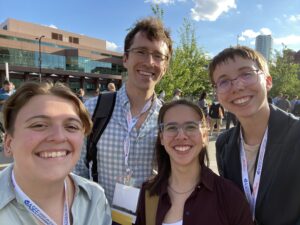
Shannon with fellow C-SED Graduate Staff
Shannon’s time at C-SED
During their 3 years at the Center of Socially Engaged Design, Shannon greatly expanded their research interests, skills, and plans for the future.
Studying ideation, divergent thinking, and engineering curriculum
Shannon’s research centers on creative problem-solving and curricular practices in mechanical engineering.
“I’ve mostly focused on ideation and problem-solving in addition to curricular messaging. What are students learning in their classes and is it aligning with what their interested in or enjoy about engineering? What do we need to support students in learning to be more creative and sociotechnical in their work?” (Shannon Clancy)
For one particular study, Shannon focused on the impact that ideation tools such as Design Heuristic Cards have on first-year engineering students. She also engaged in a project that examined how students’ divergent thinking is influenced by course resources and structures.
Shannon’s third study focused on interviewing mechanical engineering students about their values in engineering, what they learn in their ME courses, and how their learning and values align. Then, she divided students into groups based on their alignment between emphasized curricular messaging, their values and interests, and how their alignment impacts their persistence and career goals.
Excelling as a grad facilitator and lab manager
In August 2021, Shannon began working with C-SED as a grad facilitator and lab manager. Her experience in both of these roles provided her with many learning opportunities to expand her skill set.
The community of facilitators and staff Shannon has worked with over the years has shown them different ways of teaching and approaching socially engaged education. For example, Claudia Cameratti-Baeza, C-SED’s Assistant Director of Experiential Learning, introduced Shannon to research-backed facilitation techniques that helped them realize the importance of designing content with intention.
“I’ve learned a lot about flexibility, designing content, and intentionality when it comes to teaching and curriculum development,” Shannon describes.
Her time as a lab manager was also valuable to Shannon’s experience. She describes how “I have learned to roll with the punches when it comes to learning alongside students.”
In addition, Shannon developed their making and building skills, and expanded their confidence with the help of previous lab manager and grad facilitator, Kaylla Cantilina. Most importantly, they learned to adapt to students’ needs to create a positive and engaging space.
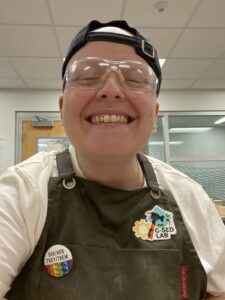
Shannon modeling proper safety apparel in the C-SED Lab
Pursuing inclusivity in Engineering
Shannon’s collaboration with C-SED not only affirmed her desire to teach but connected her with resources and useful insights. Through C-SED, Shannon has found a network of supportive individuals who share her passion for intentional teaching in engineering education.
Shannon feels motivated to help people of all identities find their space in the engineering field – especially if they may not initially see themselves as engineers.
In pursuit of this goal, Shannon envisions creating initiatives that pique students’ curiosity about engineering in unconventional ways, in addition to continuing socially engaged engineering work. Potential ideas of Shannon’s include hosting engaging events, highlighting LGBTQ+ engineers, and conducting K-12 community engagement.
“I have thought about showcasing all the different kinds of people who are engineers as well as the less known and non-traditional ways you can be an engineer. For example, in the design of makeup and toys.” (Shannon Clancy)
Centering Community
What Shannon cherished most about her roles at C-SED was the sense of community, the diverse perspectives, and the opportunity to learn from her fellow facilitators and colleagues.
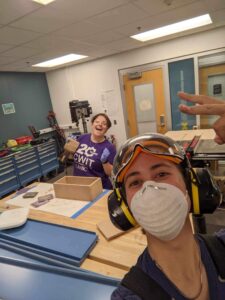
Shannon and previous C-SED Lab Manager, Kaylla Cantilina
Shannon has always valued community throughout their engineering education, but at C-SED, it’s been a crucial part of their graduate school experience both for their growth as an educator and researcher, but also on a personal level by supporting them through the challenges of graduate school.
Encouragement
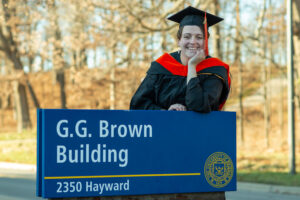
Shannon celebrating their Master’s graduation
Shannon encourages those considering roles similar to her own to explore resources, seek guidance from mentors, and conduct informational interviews about graduate school, socially engaged design, and engineering education research. For instance, there is an Engineering Education Community Resource page with graduate programs, resources, and positions. She also recommends taking the opportunity to mentor others and pursue teaching experiences such as the CRLT Teaching Certificate.
By leaning into and contributing to the C-SED community, Shannon was able to expand and realize their goals. As they move on from their time at C-SED, they go with the full support of their community.
Shannon will continue her career as an Assistant Professor of Engineering at Elizabethtown College in August 2024. Connect with Shannon on Instagram or LinkedIn.



